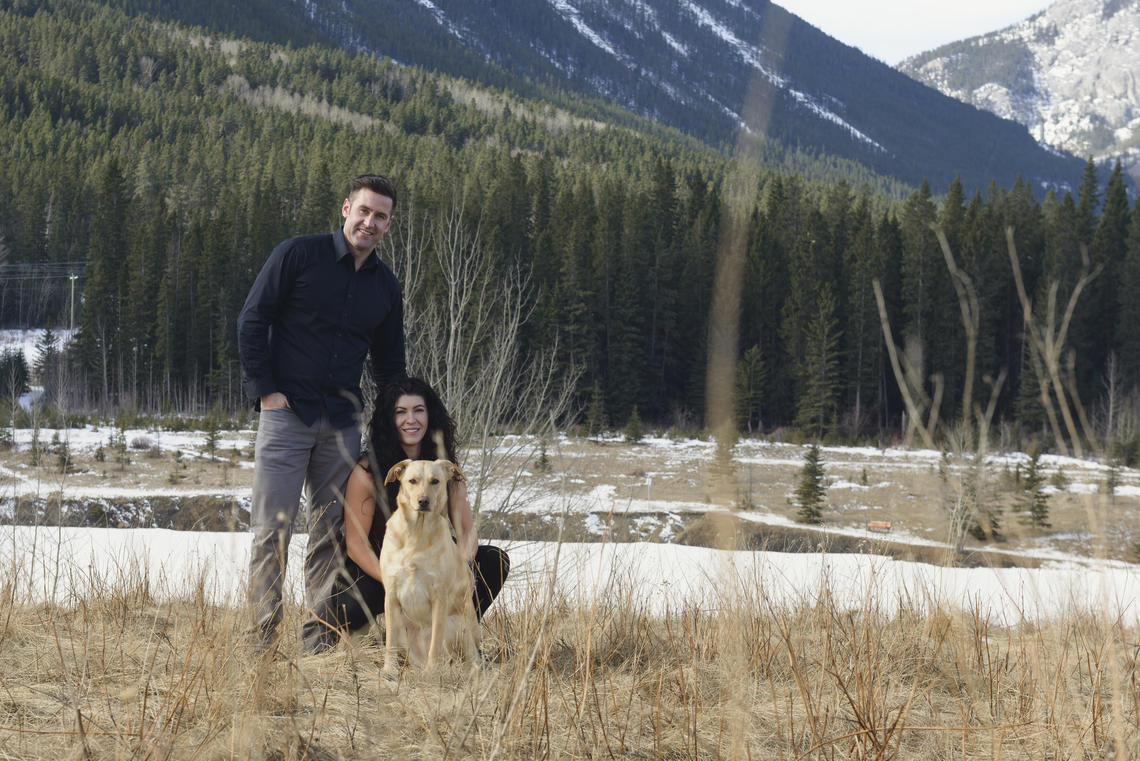May 14, 2019
Rosie's new hip: Adopted rescue dog gets a new lease on life

Rosie is no couch potato. This energetic rescue dog is a tireless ball-fetcher, swimmer, mountain hiker, and champion tail wagger.
That wasn’t the case a year ago, before Terri Schiller gave Rosie a brand new hip.
Dr. Schiller, associate dean of clinical programs and small animal surgery instructor at the University of Calgary Faculty of Veterinary Medicine (UCVM), is a leading expert in canine total hip replacement surgery. Schiller does her clinical practice at Western Veterinary Specialists and Emergency Centre in Calgary.
“She would have had an injury when she was very young to the growth center at the top of her femur. This resulted in damage to the head of the femur or 'ball' portion of the hip joint, such that it didn’t form properly,” says Schiller, pointing out on an X-ray how the hip joint didn’t fit together normally because the head of the femur was deformed and arthritic.

Rosie.
Riley Brandt, University of Calgary
A dog with a lot of heart
“When you look at how much damage there was to the bones plus all the scar tissue that Rosie had formed around the joint, she would have been in a lot of pain and yet she was still trying to do day-to-day activities. If that were you or I, we would be walking with a cane and a considerable limp,” says Schiller. “Rosie has a lot of heart.”
Rosie was adopted from the Animal Rescue Foundation at about four months of age. Her owners, Melissa Wasylenko and Terry Danku, first noticed a problem when Rosie was about two and a half.

Dr. Terri Schiller has performed about 1,000 canine total hip replacement procedures.
Riley Brandt, University of Calgary
“We’d come back from the park, you wouldn't notice anything at the park, but then she would start going up the stairs, and she literally wouldn't be using her left back leg. She'd just kind of be hopping on her right-side back leg, which is her good one,” says Danku.
After their family veterinarian examined Rosie and said it was likely hip dysplasia, the range of treatment options included surgery for a full prosthetic hip. They weren’t initially comfortable with that idea, so tried rehabilitation and water treadmill therapy.

Radiograph shows Rosie's damaged femur prior to surgery.
Riley Brandt, University of Calgary
Concerns and questions about major surgery
“We did that for about a year but she wasn't getting any better. Her muscle was super atrophied,” says Danku. “Then one of the people we ski with, who is a vet, said ‘you know what? Go see Dr Schiller. She's pretty much the best in the country at hip replacement’.”
“For a long time we didn't do the surgery because there were so many unanswered questions. I had a lot of concerns because I just didn't know what to expect,” says Wasylenko. “But Dr. Schiller was really matter of fact, and gave us good information. We felt really confident about the decision. Then the team at Western Veterinary Specialists were great and took care of everything. I just knew Rosie was getting good care.”
The surgery went well and after a few months of reduced activity Rosie was a new dog. “Her leg is great, pretty much bionic. It’s like she got a new lease on life after the surgery,” says Danku.

Similar to total hip replacements in people, Rosie was fitted with a prosthetic joint.
Riley Brandt, University of Calgary
From Yorkshire terriers to St. Bernards
Schiller has performed about a thousand total hip replacement surgeries over the course of her career — on all shapes and sizes of dogs, from a three-kilogram Yorkshire terrier to a 60-plus-kilogram St. Bernard. And she has trained many others in the procedure throughout North America and Europe. Hip replacements in dogs and cats are performed for hip conditions similar to those seen in people. Hip dysplasia and osteoarthritis are the most common reasons, but it’s also an option for certain fractures, trauma-related injuries or dislocations of the hip joint. “It can give dogs like Rosie a chance for a normal, active life without pain,” say Schiller.
“It is an advanced orthopedic procedure, using specially designed implants, requiring a trained team for placement,” Schiller explains. “It’s not an inexpensive procedure. Fortunately, a lot of pet insurance companies will cover the cost of it, and for many pet owners they want their dogs to be active and pain-free, so they consider the procedure a good investment in the long-term life and comfort of their pet and are prepared to pay for the procedure.”
Would Rosie’s owners recommend it?
“Yes,” Wasylenko says, without skipping a beat. “I've just got to say, honestly, I mean it's not a cheap procedure obviously, but man, Rosie’s mood changed afterwards. She was obviously in pain,” adds Danku. “If people can afford it, or have pet insurance, 100 per cent I would do this.”

Terry Danku and Melissa Wasylenko, say their rescue dog Rosie got a new lease on life.
Melissa Wasylenko
